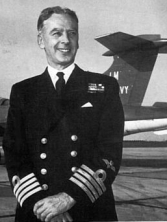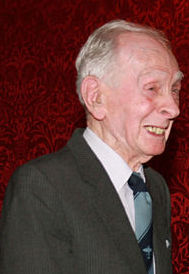News and Views from Scotland

Captain Eric "Winkle" Brown CBE, DSC, AFC, Hon FRAeS, RN
Captain Eric Melrose Brown in front of a Blackburn Buccaneer,
one of the 487 different types of aircraft he flew
Captain Eric Melrose Brown, regarded as Britain's most distinguished pilot, was a short man. At five foot 7 in, his small stature earned him the nickname "Winkle" but proved to be a huge asset and allowed him to curl up in the cockpit and avoid having his legs sheared off during a crash landing. He died peacefully earlier this year at the age of 97.During his career he flew 487 differing types of aircraft (listed on Wikipedia and verified by the Guinness Book of Records. His 2,721 take-offs from aircraft carriers and 2,407 landings are world records.
His wartime service was with the Navy's Fleet Air Arm. He combined technical expertise with great bravery. Flying Grumman Martlets (Royal Navy version of F4F Wildcat - pictured here) off a carrier he worked out the only way to destroy Focke-Wulf Kurier bombers was to attack them head-on. When V1 flying bombs appeared he worked out that if he overtook the missile he could clip its wing with his and send it into the Channel.
He had many near-fatal encounters. His jet-powered flying-boat crashed into debris off Cowes and trapped him under water. In a Tempest V his propeller froze in mid-flight and the engine caught fire. There were many other mishaps, but his natural ability, grit and painstaking research into hundreds of types of aircraft stood him in good stead.
Brown was responsible for at least two important firsts in carrier aviation – the first carrier landing using an aircraft equipped with a tricycle undercarriage (Bell Airacobra Mk 1 AH574) on the trials carrier HMS Pretoria Castle on 4 April 1945 and the world's first landing of a jet aircraft on an aircraft carrier, landing the de Havilland Sea Vampire LZ551/G on the Royal Navy carrier HMS Ocean on 3 December 1945 (graphic via Wikimedia Commons ).
He was born in Leith and won a scholarship to the Royal High School in Edinburgh. He was a talented linguist and would become fluent in German. As a boy he supplemented his pocket money by riding the 'Wall of Death' in a motorbike and earned the equivalent of a bank manager's salary. He was the only boy in the school to own a Norton 500 cc motorcycle.
After the war he helped interrogate Nazi prisoners including Herman Goering for whom he had a grudging respect as an able and charismatic man. He refused Goering's offer of a handshake but they exchanged the traditional Luftwaffe greeting of "Hals und Beinbruch!" - which is akin to actor's 'break a leg' words of encouragement.
After the war he became a test pilot at the Royal Aircraft Establishment at Farnborough and undertook many hazardous flights on some of the exotic planes captured from the Germans. He survived a flight in the potentially lethal Me 163B, powered with rocket fuel so volatile that a bump on landing could explode the plane. (The graphic here shows the Me163b on display at the Scottish Museum of Flight at East Fortune, east of Edinburgh).
He retained his distinctive Scottish burr all his life and chose "Amazing Grace" as one of the BBC Radio show "Desert Island Discs". Despite his great intellect and bravery he was a modest man with enormous charm.
This small man was truly a giant of aviation.
Please give me whatever feedback comes to mind via david@rampantscotland.com.
David
23 April 2016Return to News and Views Index
Where else would you like to go in Scotland?




